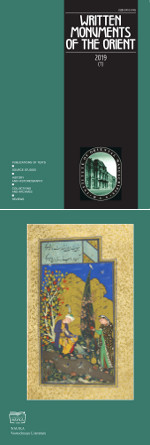 | Written
Monuments
of the Orient 1(9), 2019
ISSN 2410-0145 Issued twice a year
The entire issue as a *.PDF file
Peter Zieme. Notes on a Manichaean Turkic Prayer Cycle — 3
In this paper a recently identified new Manichaean-Turkic fragment (SI6621)
from Toyok Mazar is analyzed and edited. This manuscript written on the verso side of a
Chinese Buddhist scroll belongs to the Serindia Collection of the Institute of Oriental
Manuscripts (IOM) of the Russian Academy. It is compared with other fragments of
several manuscripts published earlier. On the basis of the new evidence, reading and
translation can be improved.
Key words: Serindia Collection, Manichaean-Turkic, Manichaean hymn, comparison of
different manuscripts
Olga Lundysheva, Anna Turanskaya. Brāhmī glosses of the Uygur blockprint of Sitātapatrā dhāraṇī kept in the IOM, RAS — 12
This paper deals with the fragment of one of the blockprint Sitātapatrā editions
that belongs to the Serindia Collection of the Institute of Oriental Manuscripts of the
Russian Academy of Sciences at St. Petersburg. The authors focus on Brāhmī parts
included into the Uyghur text. Some observations on the correlation of Uygur script signs
and akṣaras in Brāhmī are made. The Chart of akṣaras found in the blockprint is attached.
Key words: Brāhmī akṣara chart, Brāhmī glosses, Old Uyghur Sitātapatrā blockprint
Safarali Shomakhmadov. Vyākaraṇa as a Method of Rational Cognition in the Buddhist Written Sources — 24
The article is devoted to the substantiation of the statement that the Buddhist
vyākaraṇa is the method of rational ‘forecast’ and at the same time the ‘fore-knowledge’
(from Greek prognosis) itself. The proofs that the conventional meaning ‘prophecy’ is
invalid are given. The reasons of the opinion that vyākaraṇa is the ‘prognosis’ are based
of Buddhist canonical and post-canonical texts. Vyākaraṇa as the dialectical method of
the Buddhist philosophy allows to model the scheme of the good conduct that leads to
the obtaining of the final goal of the Buddhist spiritual practice — the attainment of
nirvāṇa.
Key words: analysis and synthesis, Buddhist philosophy, Buddhist texts, dialectical
method, prognosis, prophecy, rational cognition, vyākaraṇa
Kirill Alekseev, Natalia Yampolskaya. On the Fragment of the Naran-u Gerel Catalogue Preserved in IOM, RAS — 37
Until recently the manuscript entitled Naran-u Gerel in the collection of
St. Petersburg State University was considered to be the only extant catalogue of the
17th c. recension of the Mongolian Kanjur. The article presents a fragment of the Kanjur
catalogue discovered among the manuscript fragments from Dzungaria preserved in the
Institute of Oriental Manuscripts, Russian Academy of Sciences. Its textual similarity to
the Naran-u Gerel and structural proximity to the manuscript copies of the Mongolian
Kanjur indicate that having been reflected in more than one catalogue the repertoire and
structure of the 17th c. recension were not that random as it was previously represented
in Mongolian studies.
Key words: Mongolian Kanjur, catalogue, Dzungaria, manuscript collection of IOM,
RAS
Zhuangsheng. The Development of Sibe Ethnic Awareness: With Special Consideration of the Sibe People of the Ili River Basin — 50
In the sixteenth century, the Sibe people emerged as a unique ethnic group, and
they remained a unique ethnic group after their migration to the Ili River basin. In the
Republic of China, a time when many ethnic systems were created, the Sibe gained official
recognition for being an independent ethnic group. Although the creation of a written
script is an act of ethnic construction, the Sibe written language could never break
free of its close relation to the Manchu written language. The construction of ethnic
groups and the creation of written scripts stimulated vigorous development of ethnic
histories compiled by the Sibe scholars, and it is their textual research of ethnic origin
that best illustrates the birth of this new ethnic group.
Key words: ethnic groups, the Sibe people, the Sibe script, ethnic history, the Jurchen
people
Anton Popov. Two Mongolian Official Papers Dated by the 19th c. — 77
The article presents transliteration and commented translation of two official
letters written by Mongolian administrative functionaries in the first third of the 19th c.
Both were brought from Mongolia by A. M. Pozdneev. In 1898, handwritten copies were
published by G. Dz. Tsibikov in the collection of materials, as a training manual for practical
course in Mongolian language. The above mentioned letters still have not been subjected
to any kind of scientific analysis. However, these documents represent typical
examples of Mongolian official correspondence dated to the 19th c. Moreover they are
abandoned of little-known facts about relationship between the authorities of the North
Mongolian banners (khoshuns) and administrative structures, constituted personal subjects
assigned to the Treasury of Jibzundamba Khutugtu (the Shabi).
Key words: official documents, Mongolian administration in the Qing period,
A. M. Pozdneev, G. Dz. Tsibikov, the North Mongolian banners, the Shabi of Jibzundamba
Khutugtu
Reviews
The State Hermitage Museum (ed.): Brush and Qalam: 200 years of the collection of the Institute of Oriental manuscripts. Exhibition catalogue. St. Petersburg: The State Hermitage Publishers, 2018. — 320 pp. by Simone-Christiane Raschmann — 94
S. L. Burmistrov. Rukopisi shkoly Vedanta v sobraniiakh Instituta vostochnykh rukopisei RAN: annotirovannyi katalog [Manuscripts of Vedānta School in the collections of the Institute of Oriental Manuscripts of RAS: annotated catalogue]. Moscow: Nauka–Vostochnaia Literatura, 2018. — 479 pp. (Pismenniie pamiatniki Vostoka. CLII) by Safarali H. Shomakhmadov — 99
|

